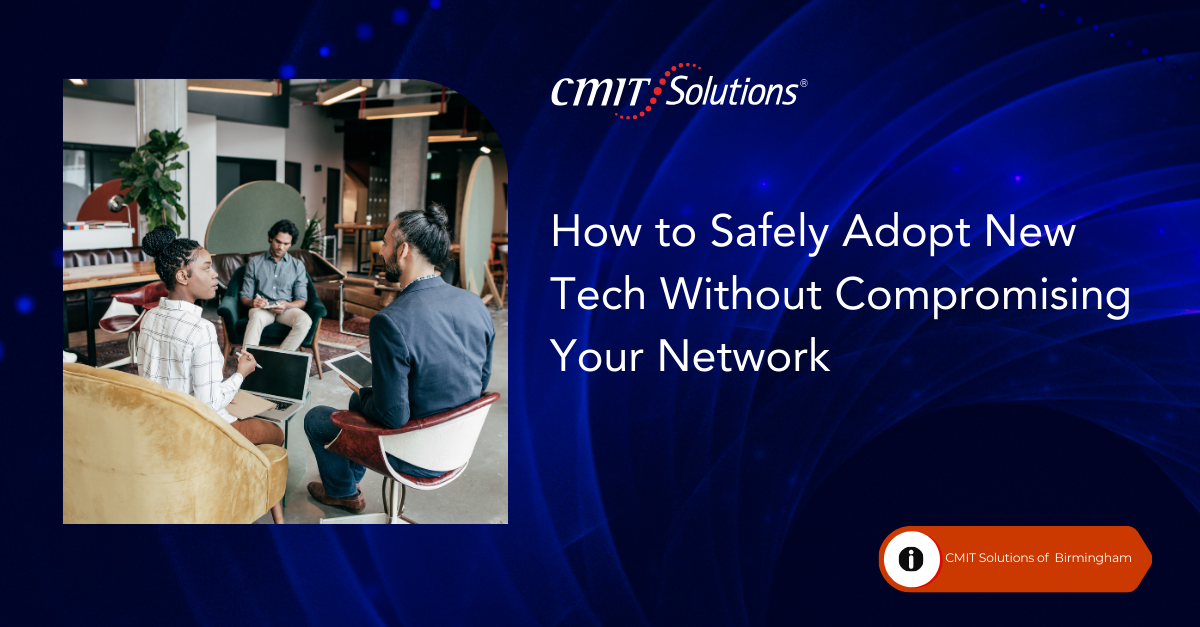Innovation is no longer optional. For Birmingham businesses, adopting new technologies is the only way to stay competitive in a fast-moving marketplace. Artificial intelligence, hybrid cloud, and advanced communication tools are transforming industries at record speed. But there’s a challenge: every new system introduced into your IT environment adds complexity and if not managed correctly, it can weaken your defenses.
The question isn’t whether to adopt new technology, but how to do it safely without exposing your network to risks.
The Risk of Rushed Adoption
Too many businesses rush into deploying the latest tools without proper evaluation. This leaves gaps in security, increases downtime, and sometimes even breaks compliance.
CMIT Birmingham highlights in its article on Zero Trust that traditional security models fail when new tech is added without safeguards. Every device, app, or system must be continuously verified.
Executives should understand that adopting new technology safely is a process, not a quick install.
Why SMBs Face Greater Risks
Large corporations often have full teams dedicated to testing and implementing new tools. SMBs in Birmingham, however, typically run leaner operations. This makes them more vulnerable when new technologies are misconfigured or poorly integrated.
CMIT Birmingham explains in its IT support feature that reactive approaches are no longer sustainable. SMBs must adopt proactive monitoring and managed IT services to keep networks secure while innovating.
Building a Cloud-First but Secure Foundation
Most modern tools run in the cloud. From collaboration platforms to AI-powered analytics, the cloud is now the default backbone. But not all cloud adoption is safe.
CMIT Birmingham warns in cloud strategy that moving to the cloud without planning causes overspending and weak security. Their hybrid cloud guide demonstrates how hybrid models balance cost, security, and performance.
Safe cloud adoption requires:
- Governance policies on who can access what
- Multi-factor authentication for all logins
- Automated backup and recovery systems
- Regular audits of usage and spending
Networks as Your First Line of Defense
Your network is the core of your digital infrastructure. Adding new tools without updating network architecture is like leaving doors unlocked.
CMIT Birmingham’s network management coverage shows how automation and segmentation reduce risks.
Executives should ensure networks are:
- Monitored in real time
- Segmented to isolate untested systems
- Built with redundancy to prevent single points of failure
Compliance in the Age of New Tech
Introducing new technology without considering compliance is a common mistake. Whether dealing with GDPR, HIPAA, or financial regulations, companies must ensure every tool aligns with governance.
CMIT Birmingham explains in its compliance automation article that automation reduces risk. Their audit readiness piece stresses that audits are becoming more intelligent, and systems must keep up.
Compliance must be embedded in every stage of technology adoption—not treated as an afterthought.
Smarter Procurement: Choosing the Right Tools
Many security failures originate from poor procurement decisions. Buying technology without evaluating vendors or integration capabilities exposes networks to vulnerabilities.
CMIT Birmingham’s tech buying guide stresses that executives must look beyond price tags.
Before buying, ask:
- Does this solution integrate with current systems?
- What’s the vendor’s security and compliance record?
- Will this scale with projected growth?
- Does it come with strong, ongoing support?
Backup and Business Continuity Safeguards
Even the best new technologies can fail. That’s why backup and recovery strategies are critical before adopting anything new.
CMIT Birmingham’s article on backup strategies demonstrates how modern, automated systems restore operations quickly.
Executives should ensure recovery times are measured in hours, not days, when introducing new systems.
Communication Platforms: High Value, Low Risk
Not all technologies carry high adoption risks. Unified communication platforms are one of the most effective and safest upgrades for SMBs.
CMIT Birmingham explains in its UCaaS feature that local firms are moving to integrated platforms to improve collaboration and customer engagement.
Even low-risk adoptions like UCaaS should be tested for compatibility and monitored for security.
Training Employees for Secure Adoption
The biggest vulnerabilities often come from people, not systems. When adopting new tools, employee training is critical.
CMIT Birmingham highlights in its help desk article that inadequate IT support leaves employees guessing—and making costly mistakes. A structured training program ensures staff use new tech properly and securely.
Learning from Global IT Failures
Global outages and breaches remind us that innovation without safeguards can cripple entire industries. SMBs must learn from these failures before they repeat them.
CMIT Birmingham’s consulting services translate global lessons into local strategies, helping Birmingham SMBs adopt new tech with confidence.
Conclusion: Innovate with Confidence, Not Risk
Adopting new technology is essential for growth, but only when done securely. For Birmingham SMBs, the path forward is clear: combine proactive IT support, secure networks, compliance automation, smarter procurement, and modern backup strategies.
With trusted IT partners, businesses can innovate boldly without putting their networks at risk. The goal isn’t just adopting technology—it’s doing so in a way that builds resilience, security, and long-term competitive advantage.







